Abstract
Salmonella DNA was partially digested with EcoRI, and the digest was fractionated to obtain fragments larger than 8 kilobases (kb). These were ligated into EcoRI-cut pBR322, and the mixture was used to transform Salmonella Xyl- cells selecting for ampR xyl+ transformants. A 21- and a 27-kb plasmid were isolated, both of which contained the entire xylose regulon. The xylose regulon was localized to a 6.3-kb segment of a 13.5-kb EcoRI fragment. Subclones were constructed which contained either the genes for D-xylose isomerase and D-xylulokinase or the genes for the D-xylose transport and the D-xylose regulatory factors. The gene order determined by the subcloning experiments is consistent with that determined by genetic mapping. The spots corresponding to D-xylose isomerase and D-xylulokinase subunits were identified in two-dimensional gels of several xylose-induced strains. Each of them had a molecular weight of 45,000 and an isoelectric point of 6.2 +/- 0.1.
Full text
PDF






Images in this article
Selected References
These references are in PubMed. This may not be the complete list of references from this article.
- Holmes D. S., Quigley M. A rapid boiling method for the preparation of bacterial plasmids. Anal Biochem. 1981 Jun;114(1):193–197. doi: 10.1016/0003-2697(81)90473-5. [DOI] [PubMed] [Google Scholar]
- Lederberg E. M., Cohen S. N. Transformation of Salmonella typhimurium by plasmid deoxyribonucleic acid. J Bacteriol. 1974 Sep;119(3):1072–1074. doi: 10.1128/jb.119.3.1072-1074.1974. [DOI] [PMC free article] [PubMed] [Google Scholar]
- Ljungdahl L. G., Bryant F., Carreira L., Saiki T., Wiegel J. Some aspects of thermophilic and extreme thermophilic anaerobic microorganisms. Basic Life Sci. 1981;18:397–419. doi: 10.1007/978-1-4684-3980-9_23. [DOI] [PubMed] [Google Scholar]
- Maleszka R., Wang P. Y., Schneider H. A Col E1 hybrid plasmid containing Escherichia coli genes complementing d-xylose negative mutants of Escherichia coli and Salmonella typhimurium. Can J Biochem. 1982 Feb;60(2):144–151. doi: 10.1139/o82-020. [DOI] [PubMed] [Google Scholar]
- Morrison D. A. Transformation in Escherichia coli: cryogenic preservation of competent cells. J Bacteriol. 1977 Oct;132(1):349–351. doi: 10.1128/jb.132.1.349-351.1977. [DOI] [PMC free article] [PubMed] [Google Scholar]
- O'Farrell P. H. High resolution two-dimensional electrophoresis of proteins. J Biol Chem. 1975 May 25;250(10):4007–4021. [PMC free article] [PubMed] [Google Scholar]
- Oakley B. R., Kirsch D. R., Morris N. R. A simplified ultrasensitive silver stain for detecting proteins in polyacrylamide gels. Anal Biochem. 1980 Jul 1;105(2):361–363. doi: 10.1016/0003-2697(80)90470-4. [DOI] [PubMed] [Google Scholar]
- Robbins J., Rosteck P., Jr, Haynes J. R., Freyer G., Cleary M. L., Kalter H. D., Smith K., Lingrel J. B. The isolation and partial characterization of recombinant DNA containing genomic globin sequences from the goat. J Biol Chem. 1979 Jul 10;254(13):6187–6195. [PubMed] [Google Scholar]
- Shamanna D. K., Sanderson K. E. Genetics and regulation of D-xylose utilization in Salmonella typhimurium LT2. J Bacteriol. 1979 Jul;139(1):71–79. doi: 10.1128/jb.139.1.71-79.1979. [DOI] [PMC free article] [PubMed] [Google Scholar]
- Shamanna D. K., Sanderson K. E. Uptake and catabolism of D-xylose in Salmonella typhimurium LT2. J Bacteriol. 1979 Jul;139(1):64–70. doi: 10.1128/jb.139.1.64-70.1979. [DOI] [PMC free article] [PubMed] [Google Scholar]
- Wovcha M. G., Steuerwald D. L., Brooks K. E. Amplification of D-xylose and D-glucose isomerase activities in Escherichia coli by gene cloning. Appl Environ Microbiol. 1983 Apr;45(4):1402–1404. doi: 10.1128/aem.45.4.1402-1404.1983. [DOI] [PMC free article] [PubMed] [Google Scholar]




